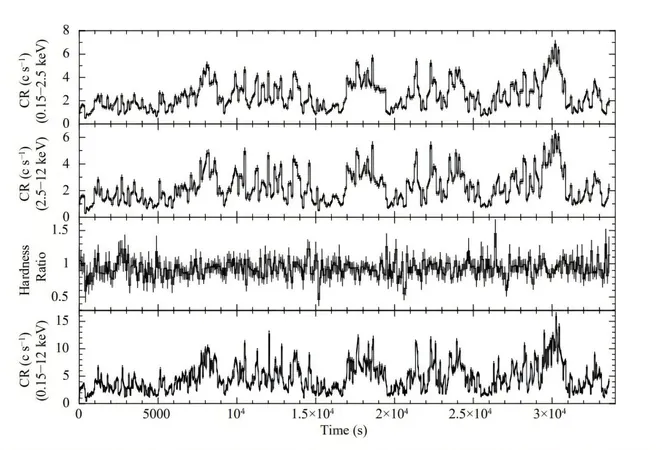
Unveiling the Secrets of X-Ray Binary 4U 0728-25: A Cosmic Mystery Deepens!
2025-04-08
Author: Wei
Introduction
In a groundbreaking study led by Italian astronomers, new observations of the Galactic X-ray binary system known as 4U 0728-25 have revealed intriguing insights into its persistent nature. Utilizing the European Space Agency's XMM-Newton satellite, the team’s findings were published on March 28, adding a significant chapter to the understanding of this fascinating celestial object.
Overview of 4U 0728-25
4U 0728-25, discovered in 1978 and located approximately 24,800 light years away, features a Be star and a neutron star, or pulsar, which spins with a pulse period of around 103.14 seconds. This binary system is classified as a Be/X-ray binary (Be/XRB), a subgroup of high-mass X-ray binaries (HMXBs). Most of these systems tend to be transient; however, 4U 0728-25 has garnered attention for its persistent nature, displaying a steady X-ray flux over extensive periods—a rarity among its peers.
High Luminosity Observations
Previous research indicated that 4U 0728-25 has an unusually high luminosity, reaching a few hundred decillion ergs per second, which places it above many other known Be/XRBs. The current study utilized advanced instruments, including the European Photon Imaging Camera (EPIC) and Reflection Grating Spectrometer (RGS) aboard XMM-Newton, to measure its properties more accurately.
Recent Luminosity Findings
Recent observations noted a startlingly low luminosity level of 90 decillion ergs per second in the energy range of 2–10 keV—marking the lowest measurement recorded for this source since its discovery and 50% less than previous minimum observations. Remarkably, this value remains less than one order of magnitude lower than its maximum luminosity detected across almost five decades, underscoring the system's limited flux variability over extended time scales.
Pulse Period and Spin-down
The study also revealed that the pulse period of the neutron star has slightly increased to approximately 103.3 seconds, suggesting a moderate spin-down that occurs through wind accretion from its Be star companion. The pulse profile maintained a simple single-peak shape across different energy levels, indicating a moderate pulsed fraction.
Spectral Analysis Findings
Spectral analysis unveiled an exciting discovery: a flux excess over the primary power-law component that can be modeled as a black body with a high temperature of around 1.5 keV and a compact emission radius of roughly 240 meters. Such characteristics contribute to the classification of 4U 0728-25 as a persistent member of the Be/XRB family, with implications for our understanding of mass transfer processes in these systems.
Conclusion
The research team, led by Nicola La Palombara of the Institute of Space Astrophysics and Cosmic Physics in Milan, concluded, "In summary, we verified that the timing and spectral properties of 4U 0728-25 align perfectly with most persistent BeXRBs, solidifying its place within this intriguing class of cosmic phenomena."
Looking Ahead
With these revelations, astronomers are one step closer to unraveling the complexities of X-ray binaries and their unique behaviors. As further studies are planned, the universe continues to intrigue, reminding us of the endless secrets waiting to be explored in the depths of space. Stay tuned for more captivating discoveries!


 Brasil (PT)
Brasil (PT)
 Canada (EN)
Canada (EN)
 Chile (ES)
Chile (ES)
 Česko (CS)
Česko (CS)
 대한민국 (KO)
대한민국 (KO)
 España (ES)
España (ES)
 France (FR)
France (FR)
 Hong Kong (EN)
Hong Kong (EN)
 Italia (IT)
Italia (IT)
 日本 (JA)
日本 (JA)
 Magyarország (HU)
Magyarország (HU)
 Norge (NO)
Norge (NO)
 Polska (PL)
Polska (PL)
 Schweiz (DE)
Schweiz (DE)
 Singapore (EN)
Singapore (EN)
 Sverige (SV)
Sverige (SV)
 Suomi (FI)
Suomi (FI)
 Türkiye (TR)
Türkiye (TR)
 الإمارات العربية المتحدة (AR)
الإمارات العربية المتحدة (AR)